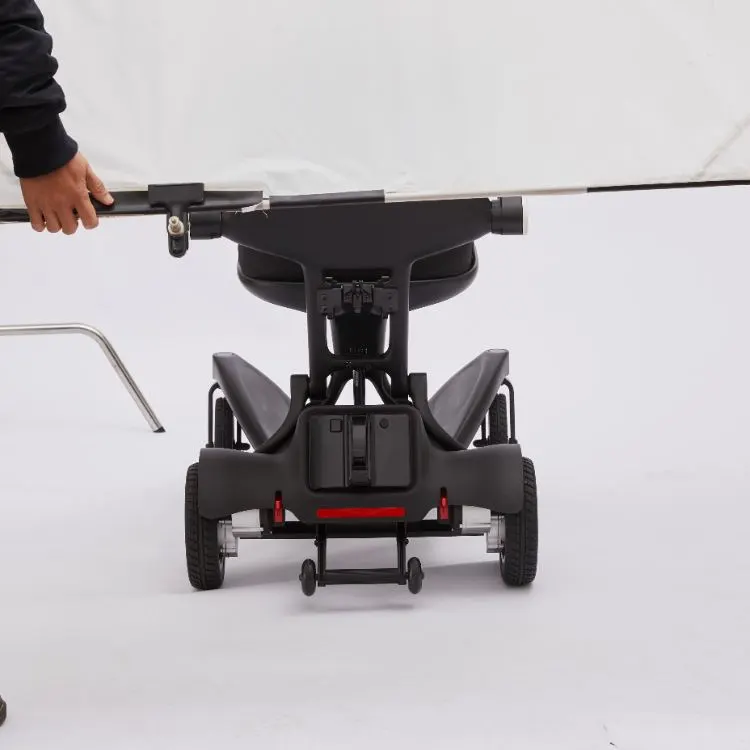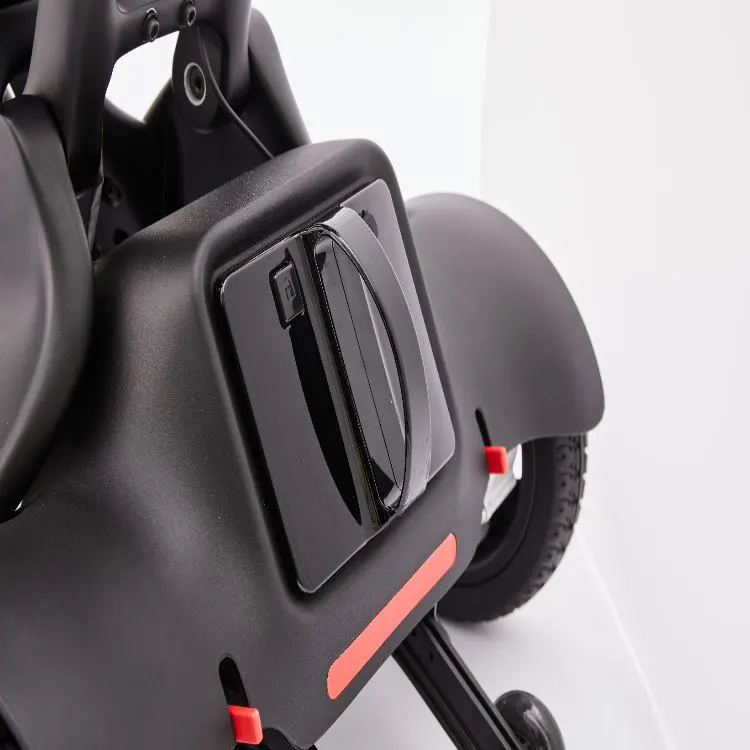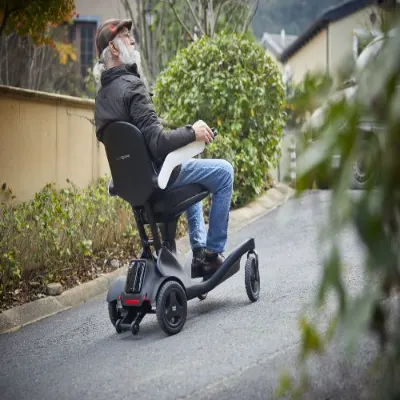
When evaluating electric wheelchairs, battery life is a crucial factor influencing daily mobility and independence. This case study looks at range at a steady 6 km/h on real sidewalks with short indoor segments, ramps, and a few stoplights. The aim is simple: what distance you can expect per charge, how much buffer to keep, and which habits stretch that buffer without slowing your day. A current lightweight platform with dual 250 W brushless motors, a 6 km/h top speed, confident brake hold on ~10° ramps, IPX4 splash resistance, a compact standing fold, and a ~21 kg frame without the battery is used as a reference for behavior and feel.
What’s the Real-World Question We’re Solving?
You want predictable range at sidewalk pace with a safe reserve. Brochure figures don’t factor stop–starts at doors, queue time, or curb lips. The goal is a repeatable method that leaves about 20% charge at the end.
Why Does a Fixed 6 km/h Benchmark Matter?
It matches the fast end of walking flow. You move with pedestrians instead of fighting them, and you can reproduce results on your own loop.
How Is the Route and Test Method Set Up?
Use a short loop: apartment corridor → elevator → sidewalk → corner store with two curb cuts each way → return. Surfaces: concrete, entry tiles, one metal plate. Mild weather baseline. Log time, average speed, elevation gain from ramps, stop count, and state-of-charge (SOC) drop.
What Counts as a Clean Data Pass?
Hold the target pace, avoid long idle chats, and repeat a lap if crowds stall you for more than a minute. The notes should reflect your chair, not the crowd.
What Variables Change Battery Life Most at 6 km/h?
Grade, payload, and stop–start rhythm move the needle fastest; tires and pressure follow.
How Do Ramps and Grade Bands Affect Draw?
Short pulls at 8–10° raise current sharply and shave range. Strong brake hold keeps motion smooth so you avoid wasteful second launches.
What About Payload and Bags?
Extra weight hurts most on climbs. Keep heavy items low and centered to reduce slip at launches.
How Do Speed Profiles and Controls Affect Draw?
A steady cruise beats surge-and-brake. Soft launch, tidy joystick response, and release-to-stop behavior prevent spikes in current.
Is a Flat 6 km/h Better Than a Mixed Pace?
Yes for energy per kilometer. If you want a livelier feel, start gently, then settle at cruise. For a quick spec skim, see steady pace vs mixed pace.
Which Micro-Habits Save Energy?
Coast early into red lights, line up straight before launching, and avoid last-second zigzags. Fewer corrections mean flatter draw.
What Are the Baseline Results at 6 km/h?
On mild days with few stops and two short ramps, you’ll see a consistent “kilometers per 10% SOC.” Multiply forward and keep a 20% reserve. Steadier speed equals steadier distance and less fatigue.
How Do You Turn SOC Drop Into a Personal Range Number?
Log distance and SOC after three to five loops, average “km per 10%,” and use that for planning.
How Do Ramps and Curb Cuts Change the Picture?
Ramps act like mini sprints; more climbs raise watt-hours and heat. Threshold lips cause brief spikes you only notice in the data.
What’s the Impact of Two vs Six Ramps?
Two adds little; six pushes extra peaks and mild heat buildup. Lower launch strength and keep a straighter pull on climb-heavy routes.
Do Threshold Lips and Plates Matter?
Individually small, but patterns kill range. Plate → turn → boost → brake wastes meters. Straighten first, then cross.
How Do Tires and Suspension Influence Range?
You want grip without drag, filtering without bounce.
Solid vs Pneumatic on Sidewalks?
Solid tires with fine tread are predictable on tile and stone and avoid flats. Pneumatics can roll lighter on long flats but add upkeep.
What Does Suspension Change at 6 km/h?
Sealed rubber-damped suspension cuts chatter over plates and seams, reducing the “stabilize” taps that lead to restarts.
What’s the Effect of Payload and Cargo Placement?
Front-heavy bags shift the center of gravity and can trigger slip on starts. Keep weight close to the seat post rather than far out on an armrest side.
How Much Does Plus Five Kilograms Change Range?
A little on flats, more on ramps. If one long climb defines your loop, split loads or slow slightly—steady beats a mid-slope stall.

How Do Weather and Temperature Shift Results?
Cold reduces effective capacity; wet lowers traction and invites wasteful spin.
Mild vs Cold Days
Pre-ride indoors, then keep the first ten minutes smooth. Cold hands make inputs choppy, and choppy costs watts.
Wet Surfaces
Use calmer starts and longer coasts into entrances. You may arrive a minute later yet finish with more charge.
Can Swappable Packs or Mid-Day Top-Ups Help?
Yes. A removable pack lets you swap and go, and short top-ups during a break recover useful charge without waiting long.
When Is a Quick Swap Worth It?
Back-to-back errands, strong headwinds, or cluster ramps. If notes show thin margins on such days, carry a spare.
Safe Quick-Charge Windows
Top-ups above very low levels are efficient. Ten to twenty minutes can recover a helpful slice.
What’s a Simple Route Calculator You Can Use?
Take your “km per 10% SOC,” multiply by eight for an 80% usable slice, then subtract a 20% buffer. If you face six or more climbs, shave another 10%. It’s rough but practical. For spec context, skim sidewalk speed range or align notes with how long does an electric wheelchair battery last at 6 km/h.
What’s the Practical Playbook to Finish With 20% Left?
Pre-ride: tire check, profiles set. On route: soft launches, straight entries, calm turns. Post-ride: log distance and SOC. After a few weeks the guesswork fades.
Weekly Notes That Pay Off
Record distance, stops, ramps, weather band, and SOC used. Circle outliers like crowd days or wind. Patterns beat memory.
À propos de Super Pi Robot
Super Pi Robot focuses on lightweight, travel-ready power chairs for real buildings and daily city routes. A current platform pairs dual 250 W brushless motors with a compact footprint around 960 × 600 × 945 mm and a standing fold near 960 × 600 × 380 mm, so you pivot cleanly in elevators and park beside a closet. The ~21 kg frame without the battery makes trunk lifts practical. IPX4 splash resistance suits wet sidewalks, while independent rear suspension with sealed rubber damping filters tile seams and plate edges. Rated climbing around 10° with confident release-to-stop braking rounds out the tools that turn a sidewalk speed range plan into consistent days on the move.
FAQ
Q1: How do you turn one loop into a personal range estimate at 6 km/h?
A: Log distance and SOC after three to five loops, average km per 10%, then plan with an 80% usable slice and a 20% reserve.
Q2: Which matters more for range, weight or ramps?
A: Both, but ramps amplify weight. Five extra kilos show most on climbs.
Q3: Does a steady pace beat mixed speed for range?
A: Yes. Steady cruise cuts surge and brake losses; see steady pace vs mixed pace for context.
Q4: What small habits extend range without slowing you down?
A: Soft launches, early coasting, straight launches before ramps, and keeping cargo low and centered.
Q5: How does cold weather change battery life on sidewalks?
A: Expect a modest drop. Warm up indoors, keep the first ten minutes smooth, and avoid wheel spin on wet tiles.






